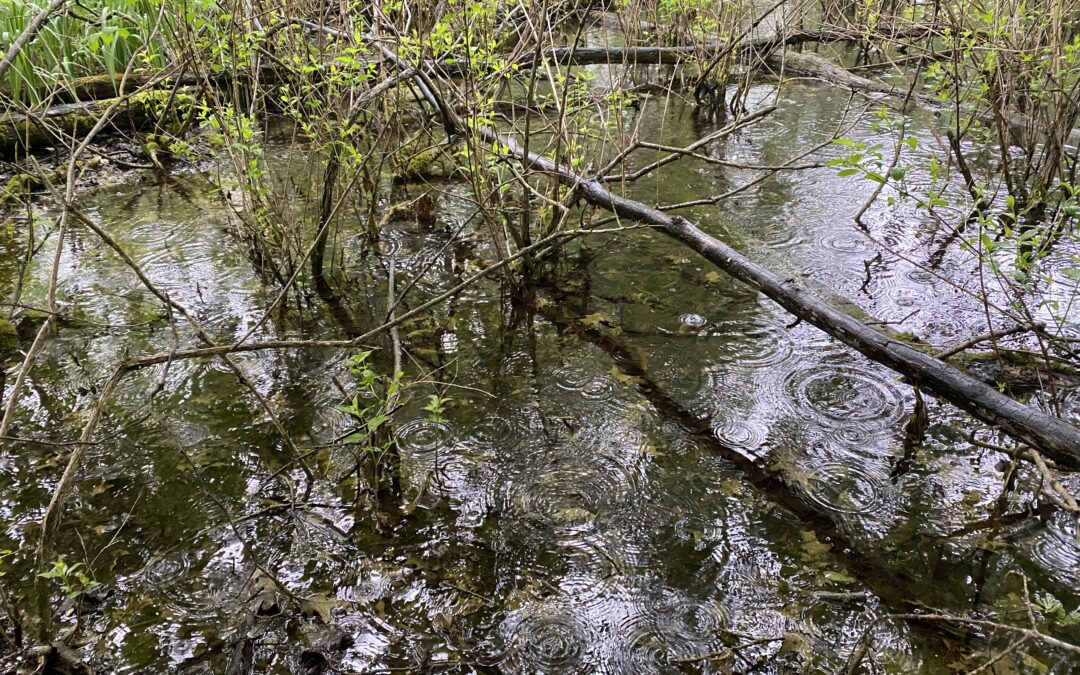I chose Maramech Forest Preserve. I craved an old natural forest. I can feel the difference between a place that simply has trees and a forest like Maramech. Peter Wohlleben, author of The Hidden Life of Trees, said that being in a forest is like being in a room pumped full of oxygen. I was reminded of the field of poppies in The Wizard of Oz, only instead of slumber; peace, focus and creativity bubble forth from the trees. There is a reason my stories usually begin in the woods.
Maramech is very small. One could park, walk directly to the path and follow it to the overlook, reaching the destination within fifteen minutes. Moving straight into the forest was too easy. I wanted to savor the experience, ease into it, so I walked the loop half a dozen times before entering the woods. It was important to work for the honor to enter. Round and round, I crunched along the crushed gravel. Green clover’s pink-tinged flowers created a delicate edge along the wet beige path. Circling was hypnotic, like working on a potter’s wheel. A bit of stress was left behind with each revolution.
There was a water pump with chipped green paint that reminded me of one at a cottage from my youth. Eee-haw, Eee-haw, it brayed like a rusty mechanical donkey as I pumped it for no reason at all.
I saw the silhouette of a crane high in the sky and wild turkey on the ground. A cardinal watched me from a tree. The birds didn’t mind the rain, either. When I finally entered the woods, their songs seemed louder. The chorus of birds combined with the pitter-patter of rain on the trees made me wonder what it would be like in a rainforest.
The path was long and narrow and led to a wooden platform to view the wet flatwoods. Maramech is an extraordinary place that’s been designated an Illinois Nature Preserve. The wildlife is abundant, and there are over 280 native plants, some of which are endangered. Trees are left where they have fallen, creating cover and eventually becoming compost to feed the same ground that nourished them when they stood tall, their roots deep in the earth. I watched the water as the giant drops of rain hit the mirrored surface, creating a kaleidoscope of rippling circles.
I absorbed the sight and sounds, creating an environment in my mind, an immersive memory. I wanted each cell to remember. There are surprisingly few words associated with this experience. I hold it tight in a different way.
The rain didn’t stay out and my feet were wet. I looked around and saw many invasive plants. I wonder if the woods would like to zip up while deciding “What to keep in and what to keep out?” What makes something invasive? Didn’t Nature put the “invasive” species here? Is this a human attempt to control an environment or the result of us unwittingly introducing something without consideration for the consequences?
I ponder these things as I exit and walk the loop six times in the opposite direction before leaving. An unwinding. Taking time to reflect on an experience, easing out of it, is a way of further absorbing it.
We are blessed with these natural places. I want to know them. I want to remember them.


very peaceful meditation, thank you for the audio option. invasive –> vadamus (latin like vamos) = to decamp, let us walk together –> to walk within :))
What?! Thank you for the insight. That is amazing. Like a mantra, let us walk together or better yet, go within <3
Wow Kim, that was nice. Thanks for sharing your experience.
Thanks for reading and connecting, Paul!